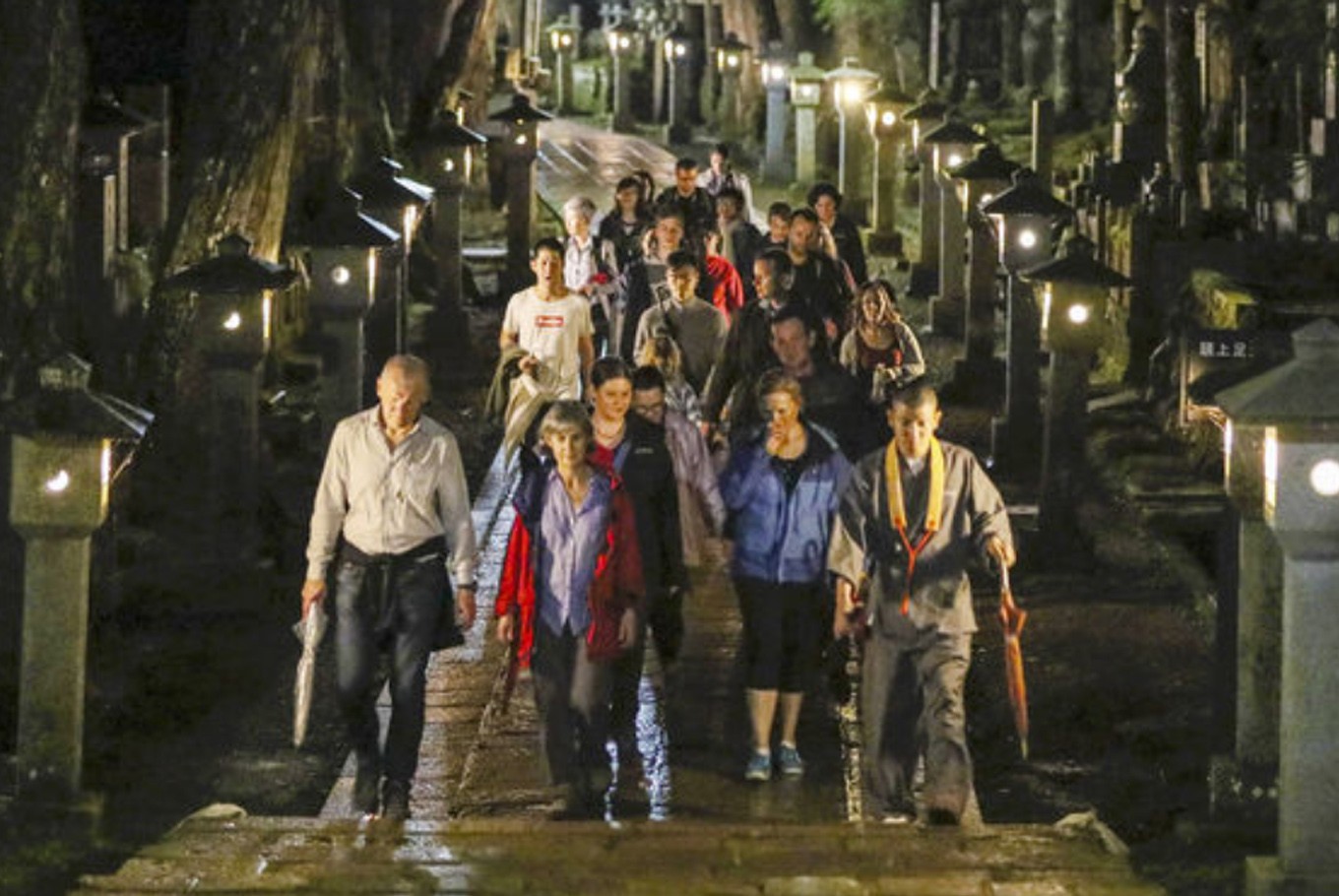Popular Reads
Top Results
Can't find what you're looking for?
View all search resultsPopular Reads
Top Results
Can't find what you're looking for?
View all search resultsNight tour at Koyasan, Japan attracts foreign tourists
Koyasan in Koya, Wakayama Prefecture, is a sacred site for esoteric Buddhism that attracts many visitors not only from Japan but also overseas.
Change text size
Gift Premium Articles
to Anyone
K
oyasan in Koya, Wakayama Prefecture, is a sacred site for esoteric Buddhism that attracts many visitors not only from Japan but also overseas. A night tour of Koyasan’s Okunoin area is gaining popularity among foreigners in search of tranquility at dusk.
The Koyasan Okunoin Cemetery Night Tour is provided daily, with explanations in English and Japanese provided by guides. Participants walk about two kilometers up to Okunoin.
Koyasan is the headquarters of Koyasan Shingon Buddhism. It was founded in 816 as a training monastery by Kukai (774-835), a monk also known as Kobo Daishi. His mausoleum is located in Okunoin, which can be accessed from Ichinohashi bridge.
(Read also: Collector cards inspire visits to dams in Japan)
I recently participated in the tour. Fortunately, the drizzling rain stopped before we set off, and the air became refreshing. A little after 7 p.m., about 40 people gathered at the tour’s meeting place, Ekoin, which is one of the temples at Koyasan that provides accommodation for worshipers.
People chose to follow a Japanese guide or an English guide and were divided into two groups of almost the same size. Many participants seemed to be from the West.
We began to walk in the dark, guided by the dim stone lanterns lining both sides of the path. As my sight became limited, I felt my other senses sharpening with each step.
The stone-paved path was slightly wet, and the moss-covered stone monuments along the way added to the distinctive atmosphere.
About 200,000 to 300,000 stone monuments are dotted across the local Japanese cedar forest, which rises more than 50 meters. They include memorials of famous war generals from the Sengoku warring states period, and also ones erected by well-known companies to remember deceased employees. There is also a cenotaph to remember victims in the 2011 Great East Japan Earthquake.
 Participants of the Koyasan Okunoin Cemetery Night Tour walk on a stone-paved path in Koya, Wakayama Prefecture.(The Japan News/The Yomiuri Shimbun/File)
Participants of the Koyasan Okunoin Cemetery Night Tour walk on a stone-paved path in Koya, Wakayama Prefecture.(The Japan News/The Yomiuri Shimbun/File)
(Read also: Exploring the grandeur of Keladi and Ikkeri)
On the way, our English-language guide, Nobuhiro Tamura, stopped to shine a flashlight on one of the monuments. “It’s a gorinto,” he said. Gorinto monuments comprise five stacked stones of different shapes.
“In Buddhism teachings, the universe consists of five elements: void, wind, fire, water and earth. Each of the five stones bears the Sanskrit word for one of the elements,” said Tamura, 32, as the participants quietly listened to his fluent English.
The tour was launched in 2010 by Tamura, a priest of the Ekoin temple. He felt that many guests at the temple had too much time to kill after dinner. To better serve an increasing number of foreign guests, he started answering their questions about Buddhism and taking them to Okunoin when he was available.
Tamura, who studied in Britain and can speak fluent English, decided to organize the tour to promote the attraction of Koyasan to more people. The tour has gradually become more well-known overseas via the internet.
(Read also: Island-hopping in Indonesia: Visiting a few from thousands)
Koyasan, located about 850 meters above sea level, stretches about six kilometers from east to west and two kilometers from north to south. It has 117 temples, including 52 that offer accommodation.
The number of foreign visitors to Koyasan has increased since 2004, when it was designated a UNESCO World Cultural Heritage site. In 2015, nearly two million visitors to Koya stayed overnight, including about 56,000 foreigners. Of those, 85 percent were from Europe, the United States and Australia.
During the night tour, Australian Jill Murphy, traveling in Japan with her four family members, said the area was particularly special at night because of the stone lanterns that provide illumination.
Okunoin is enshrouded in tranquility and darkness, and has the atmosphere of a spiritual world. Walking along, I sensed the great presence of the stone monuments that I had not paid much attention to before.
After a while, I began to feel that Kobo Daishi was warmly watching over me.
This article appeared on The Japan News newspaper website, which is a member of Asia News Network and a media partner of The Jakarta Post







